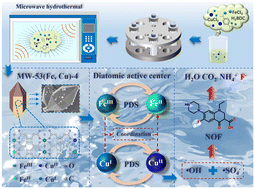Microwave synthesis of Fe–Cu diatomic active center MOF: synergistic cyclic catalysis of persulfate for degrading norfloxacin†
Abstract
The Cu-mediated bimetallic catalyst, MW-53(Fe, Cu)-4, was synthesized for the first time via the microwave hydrothermal method. This catalyst demonstrated effective removal of norfloxacin (NOF) through the activation of persulfate (PDS). The MW-53(Fe, Cu)-4 catalyst demonstrated a superior NOF removal efficiency compared to its non-doped counterpart (MW-53(Fe)), with an increase in efficacy from 13.96% to 79.97% within 5 min. Furthermore, the differences and performance improvements in terms of the morphology, specific surface area, pore diameter, and electrochemical performance were analyzed between the microwave hydrothermal synthesis catalyst materials and traditional hydrothermal materials, confirming the positive effect of the microwave synthesis method on improving the catalyst performance. Based on physicochemical characterization, the microwave synthesis method accelerated the process of Cu isomorphism substitution to change the electronic symmetry distribution of Fe sites to form an Fe–O–Cu coordinated environment. Diatomic active centers of Fe and Cu were constructed, which synergistically accelerated electron transfer on the catalyst surface, enabling the continuous catalysis of PDS. This provides a promising method for developing multi-metal catalyst materials for environmental pollution remediation using a microwave hydrothermal method.

- This article is part of the themed collection: Nanomaterial applications in water


 Please wait while we load your content...
Please wait while we load your content...